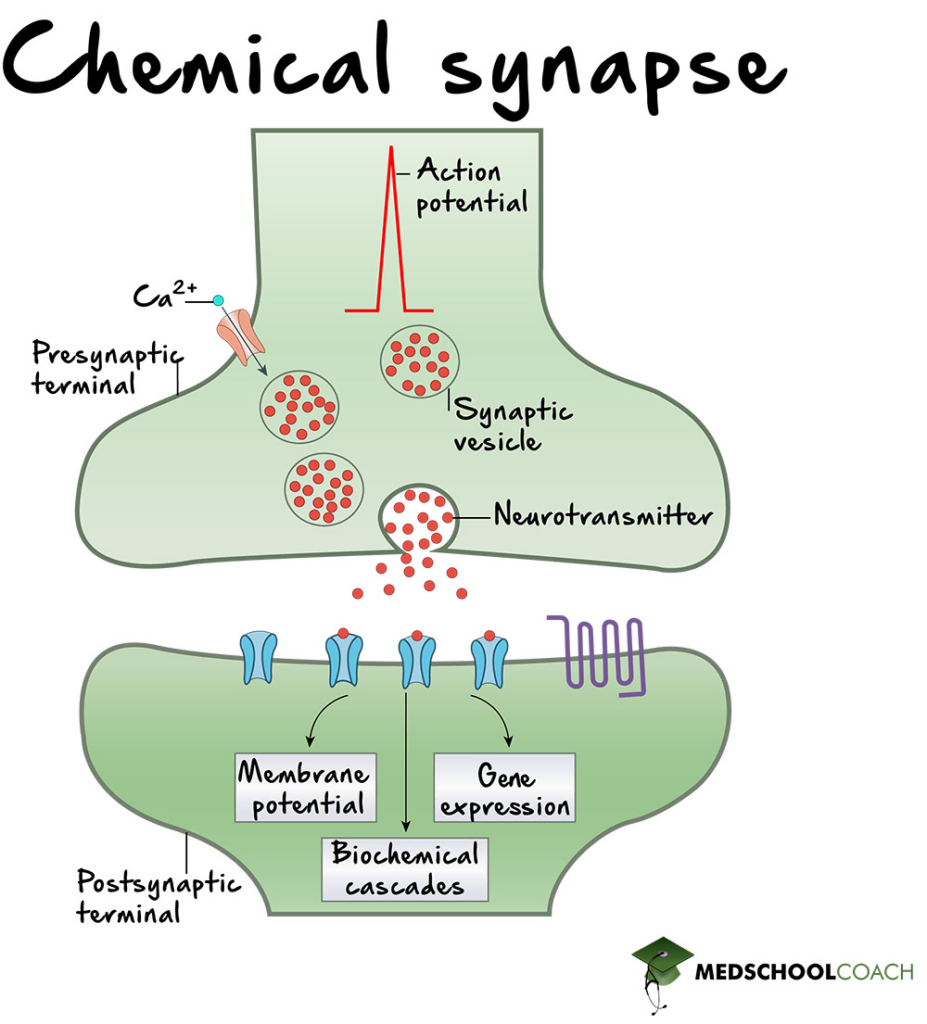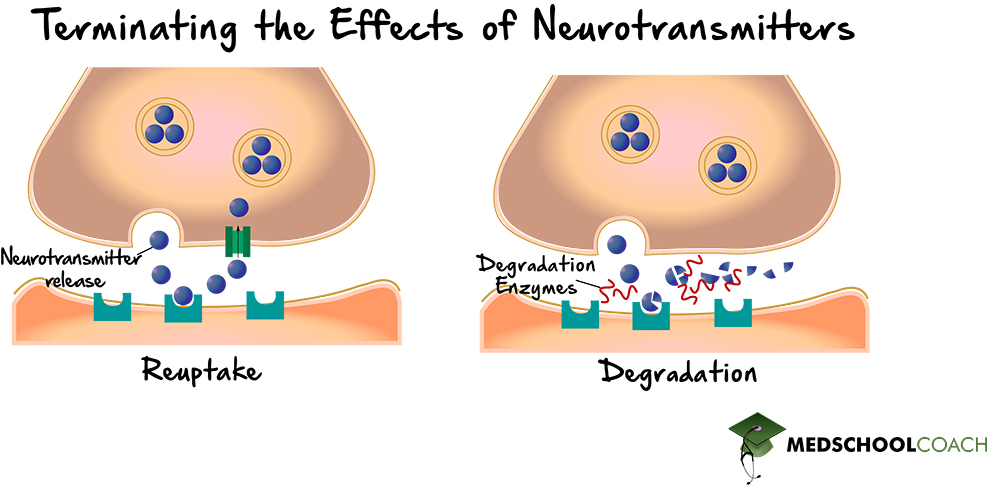Synapse
MCAT Biology
- Home
- »
- MCAT Masterclass
- »
- Biological and Biochemical Foundations of Living Systems
- »
- Biology
- »
- Synapse – MCAT Biology
Sample MCAT Question: Synapse
a) opening of voltage-gated Na+ channels.
b) opening of voltage-gated Ca2+ channels.
c) reuptake of neurotransmitters into the neuron.
d) opening of membrane channels in the post-synaptic cell.
B is correct. Opening of voltage-gated Ca2+ channels.
When an action potential travels down a neuron it will eventually reach the axon terminal, which synpases onto another cell. When the axon terminal depolarizes during an action potential, voltage-gated Ca2+ channels open and Ca2+ rushes into the neuron. This in turn causes the release of neurotransmitters from synaptic vesicles into the synaptic cleft between the axon terminal and the postsynaptic cell.
Get 1-on-1 MCAT Tutoring From a Specialist
With MCAT tutoring from MedSchoolCoach, we are committed to help you prepare, excel, and optimize your ideal score on the MCAT exam.
For each student we work with, we learn about their learning style, content knowledge, and goals. We match them with the most suitable tutor and conduct online sessions that make them feel as if they are in the classroom. Each session is recorded, plus with access to whiteboard notes. We focus on high-yield topics if you’re pressed for time. If you have more time or high-score goals, we meticulously cover the entire MCAT syllabus.
Synapses
Synapses are the junctions between two neurons, which allow neurons to pass signals to one another or to target cells. There are two different types of synapses: electrical synapses and chemical synapses. There are several significant differences between the two that are important to know for the MCAT.
Electrical Synapses
In electrical synapses (see Figure 1), the cytoplasm of two cells is connected by gap junctions. These gap junctions allow molecules to move freely from one cell to another, thereby allowing for direct cell-to-cell communication.
The fact that molecules can flow freely from cell to cell in an electrical synapse has three major consequences:
(1) It means that the postsynaptic response is always the same as the presynaptic input. For example, if one cell participating in the synapse experiences depolarization, the positive charge from that cell will move to the adjacent cell and also result depolarization. Likewise, if one cell becomes hyperpolarized, then the adjacent cell will also become hyperpolarized. So, depolarization cannot turn into a hyperpolarization, and vice versa.
(2) It means electrical synapses are bidirectional, i.e. signals can be sent in either direction. The first neuron can send signals to the second neuron, and the second neuron can send signals back to the first.
(3) It makes electrical synapses much simpler than their chemical counterparts and less subject to regulation.

Chemical Synapses
In chemical synapses (see Figure 2), the cytoplasm of the two cells is not continuous. Thus, in order to transmit signals, the presynaptic neuron releases neurotransmitters via exocytosis into the synaptic cleft, the narrow area between the presynaptic and postsynaptic neuron. These neurotransmitters diffuse across the synaptic cleft and bind to receptors on the membrane of the postsynaptic neuron. This can cause various effects in the postsynaptic neuron, including the opening or closing of membrane channels.

Signal Transmission Across Chemical Synapses
Chemical synapses are more complicated than electrical synapses. Thus, it is worth examining signal transmission across chemical synapses in more detail.
The first step in signal transmission across a chemical synapse is the firing of an action potential by the presynaptic neuron. The action potential travels down the axon and eventually reaches the axon terminal. The flow of positive charge into the axon terminal opens voltage-gated calcium channels, causing calcium to rush into the cell. The rapidly increasing calcium concentration then activates synaptic vesicles in the axon terminal, which contain chemical neurotransmitters. Once activated, the synaptic vesicles fuse to the membrane of the presynaptic cell, releasing neurotransmitters into the synaptic cleft. The neurotransmitters then diffuse across the synaptic cleft and bind to receptors on the postsynaptic neuron. This leads to the opening or closing of membrane channels in the postsynaptic neuron.
Afterwards, the synaptic neurotransmitters are either degraded by extracellular enzymes or else transported back into the presynaptic cell by reuptake transporters in the presynaptic membrane. The processes of neurotransmitter degradation and reuptake are shown in Figure 3.

Explore More MCAT Masterclass Chapters
Take a closer look at our entire MCAT Masterclass or explore our Biochemistry lessons below.

One-on-One Tutoring
Are you ready to take your MCAT performance to a whole new level? Work with our 99th-percentile MCAT tutors to boost your score by 12 points or more!
See if MCAT Tutoring can help me
Talk to our enrollment team about MCAT Tutoring

MCAT Go Audio Course
Engaging audio learning to take your MCAT learning on the go, any time, any where. You'll be on the way to a higher MCAT score no matter where you are. Listen to over 200+ lessons.

MCAT Practice Exams
Practice makes perfect! Our mock exams coupled with thorough explanations and in-depth analytics help students understand exactly where they stand.

MCAT Prep App
Access hundreds of MCAT videos to help you study and raise your exam score. Augment your learning with expert-created flashcards and a question banks.